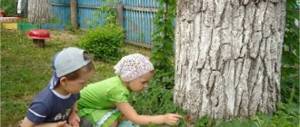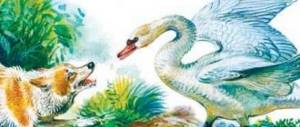Final comprehensive work of a 4th grade student (options 1 and 2)
Final comprehensive work
4th grade student
Option I
Exercise
1.
Read the text quietly, in an undertone. At the signal, mark the place where you are reading.
Bear hibernation
Everyone knows that in winter bears sleep in dens. They fall asleep long before the first snow. But in order to sleep peacefully, the bear needs to be well prepared. First of all, find a suitable place, for example a fallen tree with uprooted roots or a hole. This place must be insulated, lined with grass and moss. If the den is shallow, the bear covers it with branches and young fir trees. In winter, snowstorms will begin and cover such a house with snow. You will pass by and not even notice that a bear is sleeping under a snowdrift nearby. He feels cozy and warm in his den.
One day, scientists decided to find out exactly how a bear sleeps under the snow and what it does. To do this, they selected several animals and placed them in a fenced area with artificial dens. Each bear had special sensors attached that transmitted information about the condition of the animals. The experiment revealed that bears like to sleep curled up in a ball. They toss and turn extremely rarely - once every few days. And they breathe incredibly slowly - only two breaths per minute!
However, stories that a bear sucks its paw in a dream have not been confirmed. Scientists have not seen anything like this. During hibernation, a bear does sometimes put its paw in its mouth, but not at all because it has a reserve of fat there that helps it survive the hungry period. And, most likely, because the soles of his paws peel off in winter. They itch, so the bear scratches them with his teeth.
But not all bears sleep in winter. Among polar bears, only females eat well and fall asleep - they need strength to give birth and then feed their cubs. But males do not sleep: they are always alert and full of strength. They don't care when to dive for fish. Polar bears are the best swimmers among predators. When hunting underwater, they can hold their breath for a long time, and the speed of a swimming polar bear is impressive - seven kilometers per hour!
Diana Lapshina
Task 2.
Read the text to the end. Answer the question: “What helped scientists observe bears hibernating?”
__________________________________________________________________________ _________________________________________________________________________
Task 3.
Make a plan for retelling the text.
1. ________________________________________________________________________
2. ________________________________________________________________________
3. ________________________________________________________________________
Task
4. From the first paragraph of the text, write one word in each column.
| Verb in an indefinite form | Verb in present time | Verb in the future tense |
Task 5.
From the last paragraph of the text, write down three words: noun, adjective, verb; indicate grammatical features.
Noun _________________, initial form _______________, gender ________, declension _______, case _____.
Adjective _________________, initial form _________________,
number ________, gender in units. part ________, case ______.
Verb _________________, initial form ________________________,
conjugation ___________, person ________________, tense ________________,
number ___________, gender (past tense, singular) _________.
Task
6. Perform syntactic analysis of the sentence and analysis of sentence members and parts of speech.
In winter, snowstorms will begin and cover such a house with snow.
Task 7.
In the last sentence of the text, find information about the swimming speed of the polar bear. Fill in the missing data in the task.
The polar bear swam 91 km at a speed of ____________. How long did the bear swim?
Answer. _________________
Task 8.
Read the text.
The polar bear is one of the largest terrestrial representatives of mammals of the order of carnivores. Typically, males weigh about 450 kg, body length reaches 250 cm, height at the withers can be up to 150 cm. The length of the European brown bear is usually 2 m with a height at the withers of about 1 m and a weight of up to 4 kg. Enter
the data from this text into the table.
| Weight | Body length | Height at withers |
| Brown bear | ||
| Polar bear |
Fill in
the gaps in the sentences.
A polar bear is heavier than a brown bear by _________________________________ kg.
The body length of a brown bear is shorter by _____________________________________ cm.
The polar bear is taller than the brown bear by ___________________________________ cm.
Task 9.
Brown bears breathe incredibly slowly during hibernation - only two breaths per minute. How many breaths will a brown bear take in a day?
Please tick
the correct answer.
| 2400 breaths |
| 2880 breaths |
| 1440 breaths |
| 4800 breaths |
Task
10. Read
the text.
The brown bear is omnivorous, but its diet is 3/4 plant-based: berries, acorns, nuts, roots, tubers and grass stems. Its diet also includes insects (ants, butterflies), worms, lizards, frogs, rodents (mice, marmots, gophers, chipmunks), fish and predators. Bears also hunt ungulates - roe deer, fallow deer, deer, caribou. Brown bear loves honey. Seasonal food is fish during spawning. When the fish just begin to spawn, bears eat the entire caught fish, then begin to eat only the fattest parts - the skin, head, caviar and milt.
to
? Please tick the correct answer.
| herbivorous |
| insectivorous |
| predator |
| omnivorous |
Justify
own choice.
Task
11.
Now there are only 12-20 thousand polar bears left on the planet.
Their survival is threatened by melting ice due to climate change, poachers, and ocean pollution. Write what measures to protect these animals, in your opinion, should be taken.
Option II
Task 1.
Read the texts quietly, in an undertone.
Text 1
My love for the forest was born in my childhood.
When I was a fourth-grade high school student, our family spent the summer in the famous Bryansk forests. Previously, they were called Debryansk, from the word “wilds” - impenetrable forest thickets. In the Bryansk forest, I first met an old forester and learned a lot of interesting things from him. I learned the main thing that the forest, and the forest alone, saves the earth from drying out, from drought, hot winds, crop failure and climate damage. Every hectare of destroyed forest causes the inevitable destruction of a hectare of fertile land. The forest retains moisture. Snow in forests melts much more slowly than in treeless areas. Melt water quietly seeps into the depths of the soil. Then the forest slowly and evenly releases this moisture to nearby fields and rivers. And in treeless bare fields, melt and rainwater quickly roll into rivers, causing floods and irrevocably carrying away huge layers of fertile land... The forest feeds springs and rivers with its clean water. Most rivers originate from forest swamps and lakes. In places where the forest is destroyed, the groundwater goes very deep and the rivers begin to shallow. But the forest is not only a keeper of waters. He saves the earth from flying sands and dry winds. K. Paustovsky Text 2
I came to visit the forest and stood on the edge. The forest is looking at me, at my basket. He made way. He stretched out His path, And led to a raspberry forest, And bent down a hazel tree. He gave me a boletus and showed me a nightingale. - Come to me! - I invited him. As soon as he reached the railway, he said goodbye: “You come yourself.” Fine? Yulia Simbirskaya
Task 2.
What unites these texts? Underline your answer.
genre theme idea author
Task 3.
Title each text. 12.
________________________________
Task
4. Re-read the second text. Write what gifts the forest gave the author.
_____________________________________________________________________________________________________________________________________________________
Task 5.
Tick the line in which all the words
are
nouns of the 3rd declension.
| youth, trifle, seal |
| stump, poplar, muskrat |
| lynx, spruce, honeysuckle |
| lilac, bear, elk |
Task
6. Write out from the first text . Parse it syntactically and analyze it by sentence parts and parts of speech.
______________________________________________________________________________________________________________________________________________________________________________________________________________________________________________________________________________________________________________________________________________________________________________________________________________________________________________________________ Task 7.
Tick the diagram that corresponds to the word walk.
Task 8.
Read the problem.
In the forest nursery, Ira and Dima are treating spruce seedlings against pests. In 10 minutes, Ira processes 20 seedlings, and Dima 30. How many seedlings will they process in one hour, working together and with the same productivity? Please tick
the correct solutions.
| 20 • 6 + 30 • 6= |
| (20+30) • 10= |
| (20 + 30) • 6 = |
| 20 •10 + 30 • 10 = |
Find
the meanings of the marked expressions.
Task
9. Look at the diagram.
It shows the number of hectares of forest in different countries.
| Number it names of countries in order of increasing area occupied by forest. Countries rich in forests | |
| Russia | 809000 ha |
| Congo | 154000 ha |
| Brazil | 520000 ha |
| Canada | 310000 ha |
| Australia | 149,000 ha |
| USA | 304000 ha |
| China | 207000 ha |
| Indonesia | 94000 ha |
| India | 68000 ha |
Task 10.
Restore the sentences.
Forests influence _______________________ and processes occurring on the earth's surface. Thanks to __________________ energy, the forest can carry out the process of photosynthesis, which contributes to the release of _________________ necessary
for the life activity of representatives of the animal and plant world. Forest _____________ soil waters from their discharge with rivers into large bodies of water. The predatory ____________________ of forests along river banks leads to their catastrophic shallowing. Forest belts contribute to _________________, and also weaken the force of the wind, leading to the removal of the __________________ layer of soil. The forest serves as ______________________ for many animals.
Use
the words: sunny, climate, retain, oxygen, snow retention, clearing, fertile, habitat.
Task 11.
Read the proverbs.
1. Living near a forest means you won’t go hungry. 2. The forest is richer than the king. 3. The forest not only feeds the wolf, but also the peasant.
Explain
the meaning of one of the proverbs.
_____________________________________________________________________________________________________________________________________________________________________________________________________________________________________________________________________________________________________
Please tick
the directions for human use of forests for economic purposes.
| food source (mushrooms, berries, game, honey) |
| energy source (wood, biofuel) |
| source of raw materials (wood, resin, tar, bark) for the forestry industry |
| source of nature pollution |
| regulator of natural processes |



